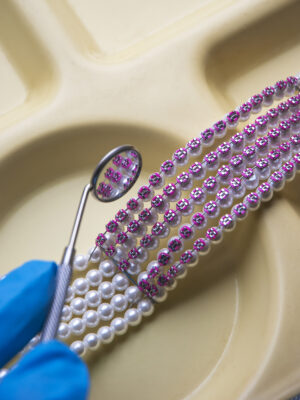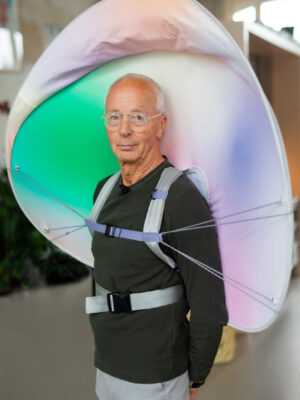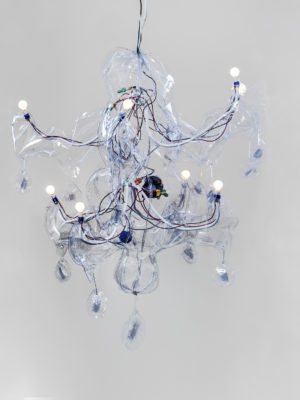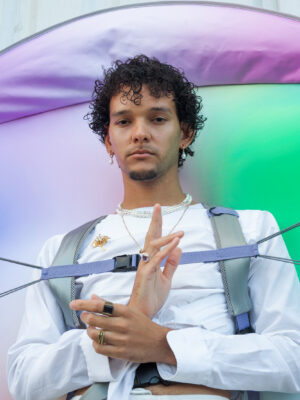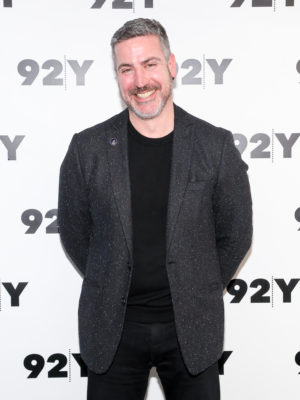The Philadelphia based JV Collective gave us such a project for MJW 2021 entitled Homeroom, where versions can be found in the MJW Paper, and on the group’s website as a digital exhibition. The project consists of thoughtfully curated photos contextualizing each of the members’ nostalgia-driven contributions in jewellery. In this show we find a set of pearls connected by orthodontic braces, one of those stretchy tattoo-chokers made of honeybee wings, a tribute to the hemp necklaces we used to excitedly make for our friends in grade school, and more. The thoughts and feelings behind this exhibition can be considered an extension of their 2020 project In-School Suspension. Originally orchestrated to be a big in-person event called Homecoming in the building of their studio (a former high school where the lockers, auditorium chairs and classrooms still remain), the group had to postpone, scale-down and pivot the call-for-entry exhibition to an entirely virtual format.
In conversation with six out of the seven members of this group – Mallory Weston, Emily Cobb, Luci Jockel (from her car!), Leslie Boyd, Melanie Bilenker and Sarah Rachel Brown (on her lunch break!) – there was a lot to understand about how being forced to switch gears actually created a special opportunity to build something new and meaningful.
Below, is a screen recording of both exhibitions.
Kellie Riggs: Would you have invested in creating such beautiful photos for the work had the In-School Suspension project been able to stay an in-person exhibition? ___STEADY_PAYWALL___
<The group unanimously shakes their heads no.>
Leslie Boyd: I think it ended up being the most amazing silver lining. I think that us approaching it from a more editorial standpoint made the work sing. The thing with Homecoming as an entire event… was that you’d have the experience of being in the school building. You’d have the experience of being in the environment, and we just knew that there was going to be no way to capture that… I don’t think it would have ever gotten to where it ended up being. And also the catalog; I don’t think we had thought about it until it became a digital project, we wanted there to be a takeaway. I don’t think that would have happened otherwise either.
Melanie Bilenker: [In regards to Homeroom] I had a lot of people that are non-jewellery people, non-art people, reach out to me independently because of the Instagram posts, just to say, ‘what is this? How do I see this? I’m so excited about this!’ I feel like so many people from all spheres of my life, felt so strongly about the content… like [Leslie’s] eye pendant, they said, ‘I had that eye pendant!’ Whatever it was; ‘My teeth hurt now!’ I feel that was a really wonderful part of it going virtual, that emphasis on outreach through social media. A lot of people looked at art jewellery that really hadn’t looked at it before.
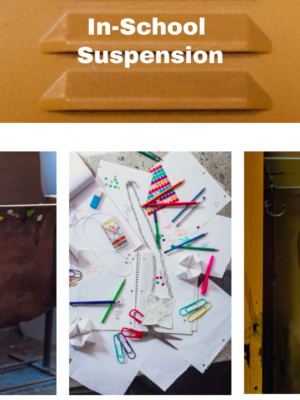
KR: How did you see the second project, Homeroom, where you got to do whatever you wanted, as more of an embrace to the virtual situation versus a reaction to it?
Luci Jockel: I think going into it, it was such a different way to approach making the piece, versus having an exhibition that we were thrown into to figuring out. For me, thinking this was only going to be in a 2D format really changed the perspective of how I was going to make this thing, and how we were all going to represent that in a magazine too. My take on it was to do something that’s impermanent anyways… but I really embraced that by having the 2D format we were able to prepare for. Some of us photographed the work on our bodies, others in other situations having other props around it to bring it to life and put it in context, and relate it back to our own high school experiences. It was all really individualized.
KR: I appreciated how far you took it. There’s a lot of storytelling happening, and the imagery does something for the work that without it, would just fall flat perhaps.
Sarah Rachel Brown: I actually didn’t even make a physical object. I keep moving further and further away from making objects, and more towards journalism and storytelling, and so I felt really comfortable to approach the group and say, ‘can I do this?’ Because we weren’t going to be in a gallery and I didn’t have to think about how I was going to put a speaker in there or something. It gave me the freedom to take the risk.
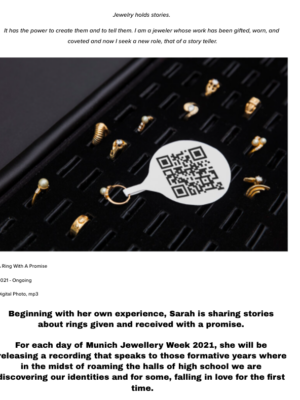
KR: Have people been tuning in and listening? <Sarah’s project included recorded stories about promise rings that you can find on her Perceived Value podcast.>
SRB: Yeah! It’s been a lot of people sending me pictures of their promise rings and telling me more stories.
Mallory Weston: For Homeroom, I don’t know if everyone felt this way, but it seemed more difficult to put that together. Maybe I was busier or it was making the piece and not just putting the show together, but I feel that pushed people to try different things, or have to switch gears in their work. I’m thinking of Maria’s piece she put together. Maria has a young child, and Covid’s going on; I remember Maria telling us she didn’t think she’d be done. So we strategized about how to put things together for the CO paper – the whole piece was inspired by this dELiA*s necklace, and the idea [eventually] came together thinking about taking the original objects, and the ingot, and Photoshopping it back into the dELiA*s catalog layout. That was such a good thing that came out of the situation; with that breakthrough you could understand her piece a little bit more. Same with the evolution with Sarah’s piece, recording people’s stories… which seemed more natural to what Sarah does really well, which made the piece stronger as she made those realizations along the way.
SRB: This also came while we were all hitting a wall with Covid… we all felt it.
Emily Cobb: But at the same time, we were all feeling that this was getting us through. As much as it felt like we couldn’t do it, we also had to do it. What I love the most about the storytelling part, we were all brooding through old photographs and documents and texting them to each other. Even if it didn’t make it into the body of work, I feel like that was part of the process too. I loved getting a vision into these people that I work so closely with in so many capacities but we didn’t really grow up together at all. I feel like I was getting to know them more hearing about what their experiences was, what they might pull inspiration from. Like Melanie, your piece with the hair – you found an old photo with your hair in that style half bleached, half not — it’s those things too I sometimes miss, that part of the storytelling that maybe people don’t get to see in the end.
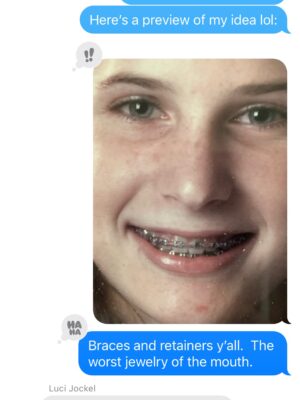
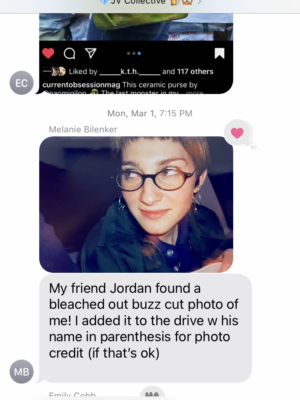
KR: I think the success of a project like this, is that you allow other people to see themselves in everything you put out. I think this tends to be lacking in conventional, white box jewellery shows; we don’t allow people to enter the work in that way.
LB: I think, and probably to some degree based on the era in which we’ve been raised, and our use of social media to begin with, which is only even more dominate with our students and younger people, that we are already interested in figuring out how can we take something that’s historically only existed in this small box of the gallery and really build beyond that. So I imagine that even when we come back to in-person experiences… we’ll always be on the look out for how things can exist with more accessibility. Not even from a stance of expanding on the medium, but also we’re really clued into and passionate about creating points of access. How can we create a new version of these experiences so they feel as exciting as going to an in-person event?
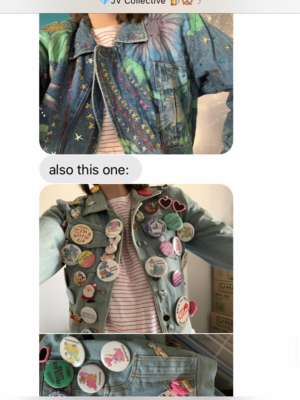
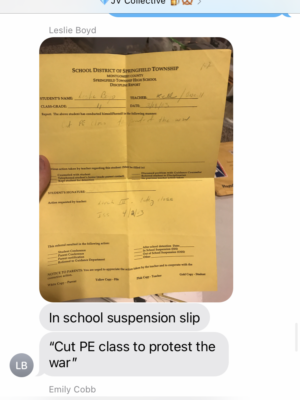
KR: Does anyone have anything to say about how their physical practice may have been influenced by image? Or how image creation is either becoming more interesting, more crucial or more integrated into your physical practice? What’s your relationship between your art and the content that it becomes?
MW: I think everybody’s interested in creating stronger visual material to be put out into the world. Having those photos on a white background for your portfolio or your website – it’s going above and beyond that and making better images that people can see and experience through social media. I don’t know how well I actually do that, but I’m interested in it.
LB: I think there’s this opportunity for art jewellery to live different lives. Think about if you borrow something from your mom or your sister, the way you’re wearing it and embodying it is so different than they did. So even just being responsive of – whether it’s the exhibition space or the medium of how it’s displayed online versus Instagram versus website – because we also did different things for IG and the website, because one thing didn’t necessarily work as well for the other. It’s really exciting and I certainly hope it keeps going further.
KR: Yes, who is do say which version of the work is more authentic than another. I think both of these projects are super singular and edited very well. I hope people notice and carry on, because not everything you put on the Internet is necessarily ‘art’ or an ‘exhibition’… What do you think the difference is between a series of photos and say, an online exhibition?
SRB: We definitely had a conversation about how we were to elevate this [project]. Everyone and their mom suddenly has an online gallery. That’s been in the back of our minds, thinking about how do we – I’m going to use a dirty word – ‘brand’ In-School Suspension, and then how do we separate Homeroom from that, roll them out in different ways, and hype them in different ways and distinguish them? We spent our whole budget on these photos, we were not going to be putting them on Instagram before Jewellery Week launched. We were really mindful. No one gets to see this shit beforehand. Even when we had a catalog [for In-School] – we thought if you were publishing those same photos on IG, who is going to buy the catalog? We’re trying to cultivate exclusivity, because you just can’t have it all. Otherwise, it’s just not that special.
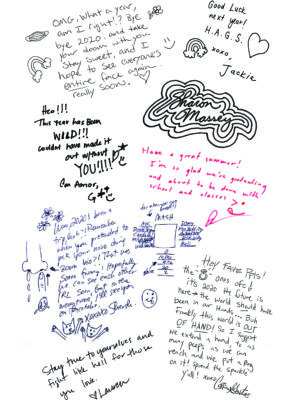
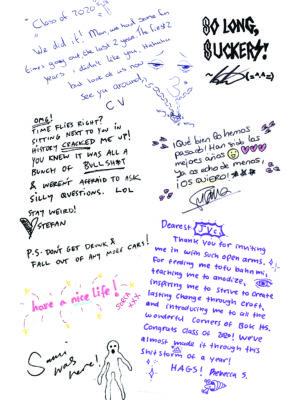
Visit JV Collective’s two exhibitions on their website: www.jv-collective.com
The full Zoom conversation, which elaborates on the group’s working dynamic, feeling connected, and more about their individual work is available for view on Current Obsession’s YouTube channel:
Glossary of terms:
Homecoming: An American high school tradition that takes place in the fall during football season, on the last home game of the year. Homecoming king and queen are usually announced there, or at the school dance that takes place that weekend, which is similar to prom.
Home game: when a football game takes place at your own school, on your own turf; an ‘away game’ rather takes place at another high school.
Homeroom: In middle and high school, homeroom is the first class of the day that takes place everyday with the same teacher, and doesn’t necessarily have a specific subject matter. The regular school day commences after.
In-School Suspension: when you get in trouble, like for skipping class, are late to class too many times, or are disruptive in class, the typical punishment is either detention (an after school session where you sit in a classroom in silence, sometimes with your head down, and not allowed to do anything until it’s over); or an in-school suspension, which is a faculty supervised type of punishment that ensures you’re still participating in some kind of academic activity but are isolated from other students. An at home suspension means you are not allowed to come to campus at all anywhere from a day or two to a week or so.
dELiA*s: The dELiA*s catalog was an iconic clothing and accessories magazine where most American adolescents did their first catalog shopping. It was characterized by laid back, late 90s/early 2000’s fashion with quippy quotes and would-you-rather questions lining each page.
This text interview is an edited version of the call that took place in April of 2021, with the exception of Maria Eife who sadly couldn’t make it!
The JV Collective was founded in 2016. They are a group of seven art jewellers that is anchored in Philadelphia but national in scope. We are friends, makers, mothers, facilitators and educators.
